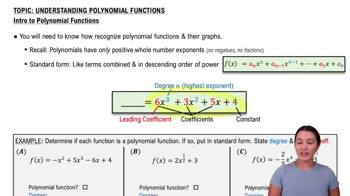Table of contents
- 0. Functions7h 52m
- Introduction to Functions16m
- Piecewise Functions10m
- Properties of Functions9m
- Common Functions1h 8m
- Transformations5m
- Combining Functions27m
- Exponent rules32m
- Exponential Functions28m
- Logarithmic Functions24m
- Properties of Logarithms34m
- Exponential & Logarithmic Equations35m
- Introduction to Trigonometric Functions38m
- Graphs of Trigonometric Functions44m
- Trigonometric Identities47m
- Inverse Trigonometric Functions48m
- 1. Limits and Continuity2h 2m
- 2. Intro to Derivatives1h 33m
- 3. Techniques of Differentiation3h 18m
- 4. Applications of Derivatives2h 38m
- 5. Graphical Applications of Derivatives6h 2m
- 6. Derivatives of Inverse, Exponential, & Logarithmic Functions2h 37m
- 7. Antiderivatives & Indefinite Integrals1h 26m
- 8. Definite Integrals4h 44m
- 9. Graphical Applications of Integrals2h 27m
- 10. Physics Applications of Integrals 2h 22m
4. Applications of Derivatives
Motion Analysis
Problem 23a
Textbook Question
Suppose a stone is thrown vertically upward from the edge of a cliff on Earth with an initial velocity of 32 ft/s from a height of 48 ft above the ground. The height (in feet) of the stone above the ground t seconds after it is thrown is s(t) = -16t2 + 32t + 48.
Determine the velocity v of the stone after t seconds.
 Verified step by step guidance
Verified step by step guidance1
Step 1: Understand that the velocity of the stone is the derivative of the height function s(t) with respect to time t. This is because velocity is the rate of change of position with respect to time.
Step 2: Write down the height function s(t) = -16t^2 + 32t + 48.
Step 3: Differentiate the height function s(t) with respect to t to find the velocity function v(t). Use the power rule for differentiation: if f(t) = at^n, then f'(t) = n*at^(n-1).
Step 4: Apply the power rule to each term in s(t): the derivative of -16t^2 is -32t, the derivative of 32t is 32, and the derivative of 48 is 0.
Step 5: Combine the derivatives to write the velocity function: v(t) = -32t + 32.
 Verified video answer for a similar problem:
Verified video answer for a similar problem:This video solution was recommended by our tutors as helpful for the problem above
Video duration:
3mPlay a video:
Was this helpful?
Key Concepts
Here are the essential concepts you must grasp in order to answer the question correctly.
Velocity
Velocity is the rate of change of an object's position with respect to time. In calculus, it is often represented as the derivative of the position function. For the stone's height function s(t), the velocity v(t) can be found by differentiating s(t) with respect to time t, yielding v(t) = s'(t). This gives insight into how fast the stone is moving at any given moment.
Recommended video:

Derivatives Applied To Velocity
Derivative
The derivative is a fundamental concept in calculus that measures how a function changes as its input changes. It provides the slope of the tangent line to the function's graph at any point. In this context, taking the derivative of the height function s(t) allows us to calculate the instantaneous velocity of the stone at any time t, which is crucial for understanding its motion.
Recommended video:

Derivatives
Quadratic Functions
A quadratic function is a polynomial function of degree two, typically expressed in the form f(x) = ax^2 + bx + c. The height function s(t) = -16t^2 + 32t + 48 is a quadratic function, where the coefficient of t^2 indicates the stone's acceleration due to gravity. Understanding the properties of quadratic functions, such as their parabolas and vertex, is essential for analyzing the stone's motion and determining its maximum height and time of flight.
Recommended video:

Introduction to Polynomial Functions

 6:29m
6:29mWatch next
Master Derivatives Applied To Velocity with a bite sized video explanation from Nick
Start learning



